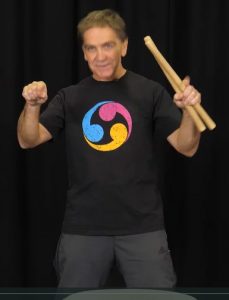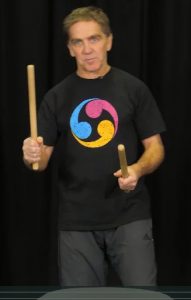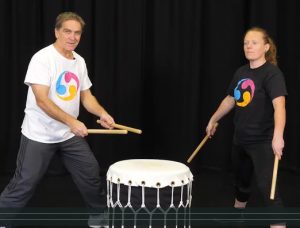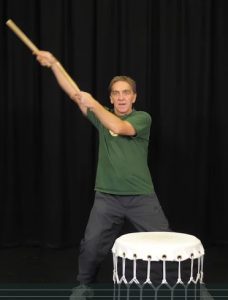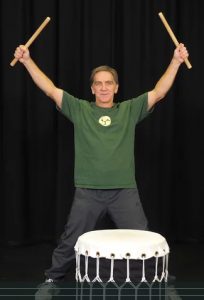Taiko for Schools, Volume 1, Fundamentals
Published in February 2018, this is book by Jonathan Kirby provides support for a set of 21 short instructional videos, designed for use by school teachers in the UK, and suitable for showing in the classroom.
The suite of short videos was produced in consultation with teachers in North Devon, and was commissioned by Devon Music Education Hub, Taiko Outreach Programme for Schools, working in partnership with Kagemusha Taiko.
Purchase of the book will provide the buyer with the password needed to use the videos. The videos cover taiko foundations, base rhythms, simple taiko motifs and some extras. The videos can all be found below.
Please go to our Taiko Store if you would like to buy a copy of the book.
Taiko Fundamentals
1. Foundations
The short training videos on this page collectively provide a guide to starting taiko. They are intended primarily for school teachers in the UK, but may be suitable for other audiences. These videos are supported by a book which can be purchased from Kagemusha Taiko. With the book comes the password that you will need to access the videos.
Please be aware that the videos can be expanded to full-screen size. All videos are suitable for classroom use.
1. Stick Grip
(2 mins)
This video provides a guide to the most useful, basic stick-grip. You will also see how different stick grips can affect the sound that you get from a drum.
2. The Ready Position
(4 mins)
In a little under 4 minutes, this video introduces the idea of the Ready Position – the way you need to stand in order to play a taiko drum safely and strongly. Getting into this position also shows everyone that you are quite literally ready to play.

3. Getting Ready to Play
(8 mins)
A taiko drum does not materialise magically in front of someone when they want to play, that person needs to approach the drum and get into the Ready Position. In less than 8 minutes, this video will show you several different ways of addressing the drum.
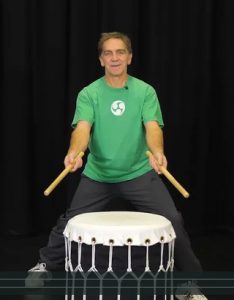
4. Big Beats
(6 mins)
Big Beats, and Spaced Big Beats in particular, provide a simple way to start to explore the notion of kata. In this video, you will see how taiko beats can look big, as well as sounding big.

5. Big Beats – Spaced and Scissored
(2 mins)
This video shows you the difference between two types of Big Beats, with a reminder that they are all about speed of movement, not muscle-power. The two different types are put together in a short sequence.
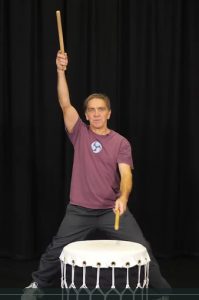
6. Taiko Motif – Power Drill
(2 mins)
Warming-up with some simple drills is a good way to start a taiko session. In this 3-minute video, you will see how to combine Spaced Big Beats with Scissor Beats (played at two different speeds), in a simple repeating pattern.

Taiko Fundamentals
2. Base Rhythms
The short training videos on this page provide guidance for teaching taiko base rhythms. A base rhythm is the pulse that underpins a taiko piece. Some might call them an ostinato, others may use the Japanese term, ji-uchi.
These videos are intended primarily for school teachers in the UK, but may be suitable for other audiences. They are supported by a book which can be purchased from Kagemusha Taiko. With the book comes the password that you will need to access the videos.
Please be aware that the videos can be expanded to full-screen size. All are suitable for classroom use.
7. Base Rhythm: Dongo
(4.5 mins)
In this video, you will get an introduction to different ways of teaching this particular base rhythm, and how to troubleshoot some common difficulties people experience when learning it.
8. Base Rhythm: DonGo with Kas
(4 mins)
While playing the same rhythm pattern, different parts of the drum can be hit. In particular, the rim of the drum can be used to contrast with the sound of the skin. This can create some great-sounding patterns, and can also service as a diagnostic.
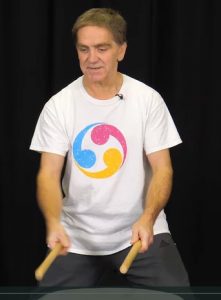
9. Base Rhythm: Straight Beats
(2 mins)
This video provides an introduction to playing straight beats as a base rhythm.
10. Base Rhythm: Straight Beats with Accents
(4.5 mins)
This video provides a guide to using accents while playing straight beats. Doing this, you can create your own base rhythms, and also create some interesting practice routines for your group.
11. Base Rhythm: Don DoKo
(2.5 mins)
Don DoKo is a base rhythm that will take a lot of practice, but the investment is repaid with a beat that’s really exciting, especially when played at a high tempo. In this video, you will get introduction to Don Doko, including some guidance on sticking. 
12. Base Rhythm: Don DoKo with Kas
(3 mins)
As an alternative to making Don DoKo more fun by playing it fast, use of the rim of the drum can make for some really fun patterns. Don DoKo can also be inverted – DoKo Don – to create new patterns.

13. Base Rhythm: Matsuri
(3.5 mins)
This base rhythm is one of a kind that you might hear at a festival in Japan. In the video, some variations are demonstrated, using dynamics, playing different parts of the drum, and making some subtle (or not so subtle) changes to the pattern.
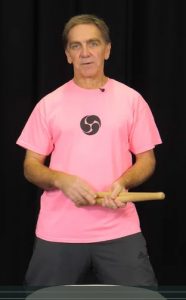
Taiko Fundamentals
3. Taiko Motifs
The short training videos on this page provide guidance for teaching some simple taiko motifs. These can form the basis for pieces that could be performed by your group. They should be regarded as building-blocks rather than finished products.
These videos are intended primarily for school teachers in the UK, but may be suitable for other audiences. They are supported by a book which can be purchased from Kagemusha Taiko. With the book comes the password that you will need to access the videos.
Please be aware that the videos can be expanded to full-screen size. All are suitable for classroom use.
14. Taiko Motif: Big Beats and Circle
(5 mins)
Don’t rush to the endgame. Practise each step on the way in order to build new taiko skills.

15. Taiko Motif: Shouts, Kas and 3 Big Beats
(7.5 mins)
This motif sits most comfortably on top of the Dongo base rhythm.
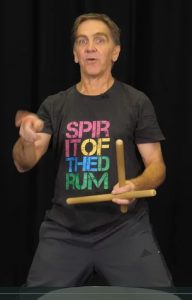
16. Taiko Motif: Matsuri
(7 mins)
Matsuri is a motif that is very recognisable as a Japanese festival rhythm. This particular variation was taught by Grand Master Seiichi Tanaka of San Francisco Taiko Dojo.

17. Taiko Motif: Two to a Drum
(2 mins)
Imagine a conversation between two people sharing a single drum…
Taiko Fundamentals
4. Extras
The short training videos on this page provide some extras.
These videos are intended primarily for school teachers in the UK, but may be suitable for other audiences. They are supported by a book which can be purchased from Kagemusha Taiko. With the book comes the password that you will need to access the videos.
Please be aware that the videos can be expanded to full-screen size. All are suitable for classroom use.
18. Extras: Movement behind the Drum
(3 mins)
Including some movement in your taiko pieces helps make it a feast for the eyes as well as a joy for the ears.
Taiko is “drum theatre”, not just musical performance.
19. Extras: I Play, You Play
(2 mins)
It’s amazing what people can play if they have to make an immediate response.
20. Extras: Experimental Sounds
(3 mins)
Four of the very many different sounds you can make with a drum, in addition to the basic Don, Ka, and click of the sticks.
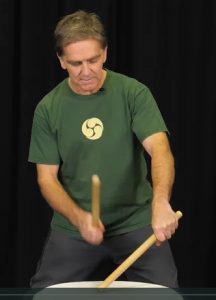
21. Extras: Two to a Drum – My Drum!
(2 mins)
Two people can battle over one drum, thirty people could battle over fifteen, or any number in between!
Free videos:
5. (Learn) Shimabayashi
Taiko Tapas
This set of approximately 20 videos can be seen as the second volume of “Taiko for Schools”, though there is no printed material to accompany them. Visit the Taiko Tapas page to find out more.






